Contents
- How to grow mycelium of shiitake mushrooms in the country
- Cultivation of flammulin mushrooms on a personal plot
- How to grow Volvariella mushrooms in a summer cottage
- Growing truffle mushrooms in the garden
- How to grow oyster mushrooms in the country (with video)
- Growing morel mushrooms and honey mushrooms at their summer cottage
- Cultivation of ring mushrooms in the country
- Tips for growing mushrooms from mycelium in the garden
There are many varieties of mushrooms that you can grow on your own site. The list of the most popular includes champignons, shiitake, oyster mushrooms and honey mushrooms. The technology for cultivating morels, ringworms, flammulins and even black truffles is also quite well developed. For some, an intensive method is used, and the breeding of other fruiting bodies is possible only in an extensive way.
To date, there are approximately 10 species of edible artificially grown mushrooms, and about 10 more are at the stage of study and development of optimal cultivation technology.
About what mushrooms can be grown in the country, and in what ways to do it, is described in detail in this material.
How to grow mycelium of shiitake mushrooms in the country
The oldest known cultivated mushroom that is grown under artificial conditions is shiitake (“black forest mushroom”), which began to be bred on wood in Japan, Korea, China and Taiwan as early as 2000 years ago (according to another version, in 1000-1100 years .). In nature, this wood-destroying fungus can still be found in China, Japan, Malaysia, and the Philippines on trees such as oak, hornbeam, and beech. The volume of industrial cultivation of mushrooms is increasing every year.
This fungus has been an important agricultural export in Japan for decades. It is this country that is the leader in the production of shiitake. They are dried and sent to France, Germany, the USA, Great Britain, where the delicacy mushroom is in great demand. In Europe and America, they also conduct research and experiment on the cultivation of this fungus.

Before growing mycelium of shiitake mushrooms in the country, you need to take a fallen hardwood tree and saw it in two along. The halves are placed obliquely and mycelium is planted on them, which “colonizes” the wood. If there is enough moisture (rain and watering), then fruiting bodies are formed on wood after 2 years. In total, the duration of mushroom picking is 6 years, while about 1 kg of fresh mushrooms are harvested from 2 m240 of wood.
For the successful cultivation of these mushrooms in the garden, it is necessary to provide a temperature in the range of 12-20 ° C and high humidity. Using modern technology, this is not difficult to achieve.
In order to grow the shiitake mushroom crop in artificial conditions as abundant as possible, you need to organize a plantation in the open air in a shady place. There are also encouraging results of cultivating these fruiting bodies in greenhouses. Of course, the use of a special room increases the cost of production, but the process does not depend on weather conditions and ensures a stable harvest.
Next, you will find out what other mushrooms are grown artificially.
Cultivation of flammulin mushrooms on a personal plot
In Japan and some Asian countries, industrial cultivation of the wood-destroying flammulina velvet-legged is popular. This is done by specialized mushroom farms, which are also called winter mushrooms.
For its cultivation, an intensive method is used and only indoors, since flammulina is able to develop as a parasite on living plants, and therefore its open breeding can be dangerous for gardens, parks and forests.
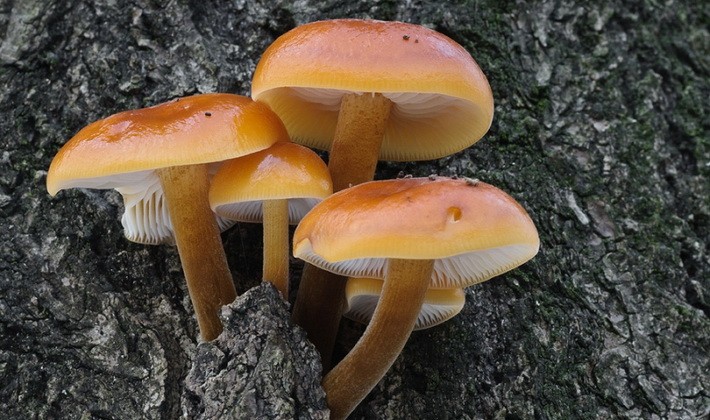
The conditions under which these mushrooms can be grown were already known in 800-900. At first, flammulina, like shiitake, was bred on wood. And how to grow these mushrooms in a garden plot in modern conditions? Now glass or plastic jars are used for this, where a substrate is placed, which is a mixture of sawdust and straw with mineral additives. All processes, from mixing the substrate to planting mycelium in it, are mechanized.
Banks are installed in special thermostatic rooms with controlled temperature, air humidity, and degree of illumination. Sufficiently long legs of fruit bodies peeking out of the jar are cut off, and soon new mushrooms appear in their place.
Experiments on the cultivation of flammulina are also carried out in Europe. Local mushroom growers have found that the best substrate for this fungus is a mixture of 70% sawdust and 30% rice bran. In the presence of such a substrate and other necessary conditions, the crop is harvested 2-3 weeks after planting the mycelium.
Watch a video on how to grow shiitake mushrooms on a plot:
How to grow Volvariella mushrooms in a summer cottage
Other mushrooms that are grown in Asian countries are volvariella, also called straw mushrooms or herbal champignons. However, they are more like fly agarics and float mushrooms. They began to breed them almost at the same time as champignons, i.e. around 1700, most likely in China
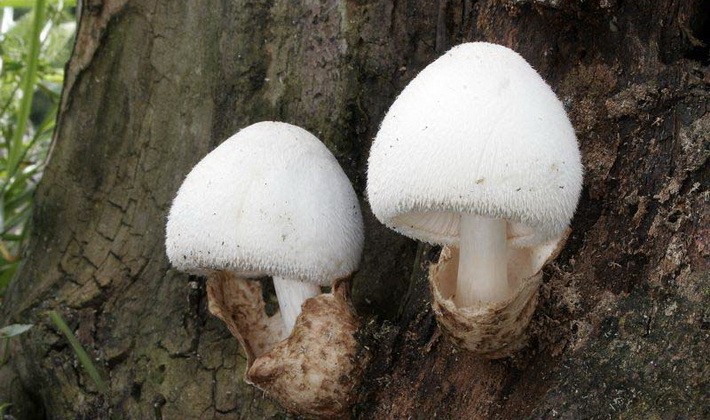

At the moment, in the countries of the Far East and Southeast Asia, volvariella is actively grown in open ground on ridges of rice straw. The most optimal combination of temperature and air humidity for the cultivation of this fungus is 28 ° C and 80% humidity. In the straw bed itself, the temperature should vary from 32 to 40 ° C.
In terms of production and popularity, of course, the leader is champignon (double-spored champignon), which began to be grown in France around 1600, in connection with which the mushroom was called French champignon for a long time.
Under natural conditions, almost all of the above mushrooms live on wood. Among the grass on the ground, you can see only volvariella, and champignon lives on rotted manure or humus.
In tropical and subtropical countries, the mushroom can be grown outdoors, which reduces its cost to some extent. In temperate areas, mushrooms are cultivated indoors, which entails significant costs, so the cultivation of volvariella is not very common in these areas. A good solution for growing these mushrooms in the country is to use greenhouses. For example, vegetables are not grown in greenhouses at the dacha in the summer, so their place may well be taken by a heat-loving straw mushroom.
Pretty good results were obtained when growing mushrooms in household plots using a substrate from ground corn cobs. Sometimes it is possible to get up to 160 kg from 1 m2 per year.
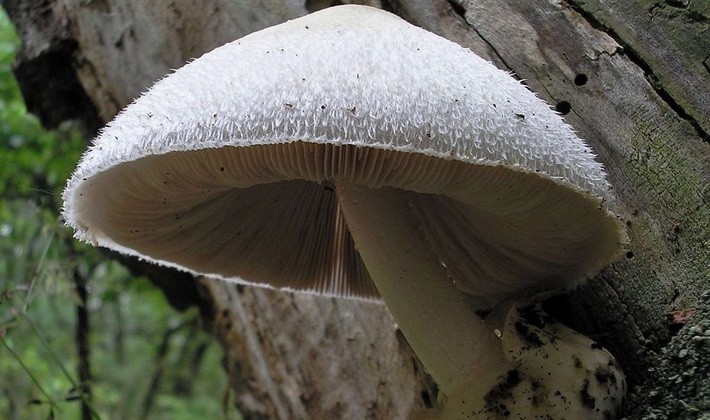

According to its structure and taste, Volvariella is a very delicate mushroom. A signal of maturity is when it reaches a weight of 30-50 g. As a rule, it is eaten fresh, and due to its delicate texture, herbal champignon cannot be transported.
In other countries, especially Asian ones, volvariella has been cultivated for a long time, but in Our Country they have come to this quite recently.
Growing truffle mushrooms in the garden
The first of the cultivated mushrooms were precisely the wood-destroying ones, since it is among all the cap mushrooms that it is easiest to get fruiting bodies from them. In humic and mycorrhizal fungi, with their complex relationship with vegetation, this is more difficult to do.
Mycorrhizal mushrooms have been studied for more than a century, but reliable methods for growing them have not yet been developed, so you have to copy nature and, having dug up a mycelium in the forest, transfer it under a tree in the forest or in your garden plot, you can also just sow spores.
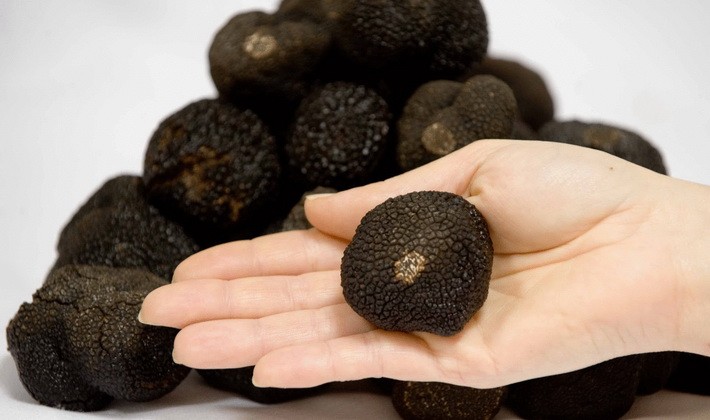

The only more or less studied mycorrhizal fungus is the black truffle, which has been widely distributed in France since the middle of the XNUMXth century. It was even called the French, or Perigord, truffle in honor of the corresponding province, where the main plantations were located. Then the French truffle began to grow in small quantities in the south of Germany.
The mushroom is characterized by a strong, persistent and pleasant smell and delicate taste, which is why it is highly valued.
At the moment, the mushroom is quite justifiably considered a valuable delicacy, the cost of which on the world market is very high.
The fruiting bodies of the black truffle are underground and, as a rule, are located at a depth of 2-5 cm, the shape is round, the surface is uneven with depressions and bulges, the color is brownish-black, it is approximately the size of a walnut or a small apple. Its main producer is traditionally France.
Is it possible to grow these mushrooms on your site? For true fans of their craft, nothing is impossible! The mechanism for growing truffles has not changed much in two centuries. As then, now natural or artificially planted oak and beech groves are used for this, since it is with these trees that the truffle willingly enters into symbiosis and forms mycorrhiza.
The distribution area of the black truffle is limited to France, Italy and Switzerland. In Our Country, its other species grow, however, they are much inferior to it in taste, so its breeding in the country is not common. In addition, he needs special crushed stone soil with a high lime content, as well as strictly defined temperature conditions and appropriate air humidity.
Agrotechnics for growing truffles is shown in these photos:
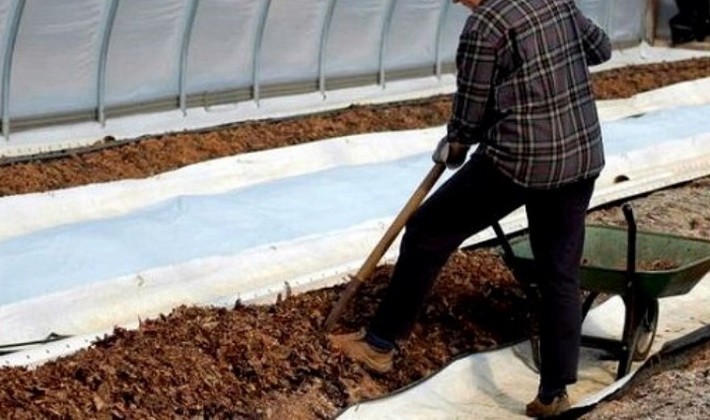

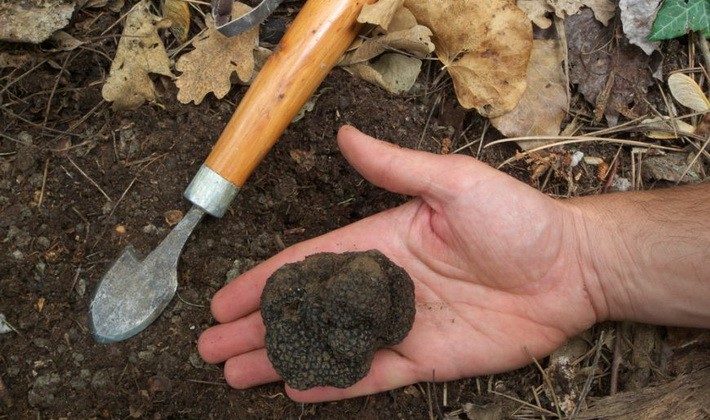

How to grow oyster mushrooms in the country (with video)
It can be seen that almost all types of edible mushrooms grown on wood began to be cultivated in the countries of the Far East and Southeast Asia. An exception is the traditional wood-destroying mushroom called oyster mushroom, which began to be bred in Germany at the turn of the XNUMXth-XNUMXth centuries. Recently, this mushroom has become widespread in Europe, Asia and America.
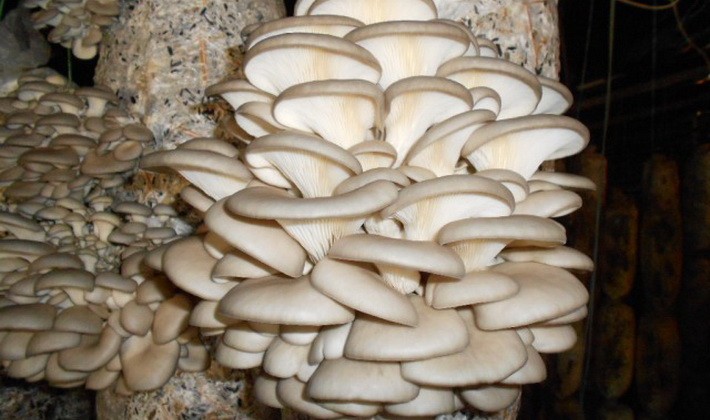

Oyster mushroom is a valuable edible mushroom, which is much easier to cultivate than champignons. Moreover, both in taste and in appearance, oyster mushroom is similar to shiitake, only the color of the cap of the latter is dark brown, and the central leg is, as a rule, more pronounced than the lateral one of oyster mushroom.
The oyster mushroom culture is characterized by high yields in the open field and excellent taste, so it is justly loved among amateur mushroom growers.
When cultivating oyster mushrooms, an extensive method is used.
Details on how to grow oyster mushrooms in the country are described in this video:
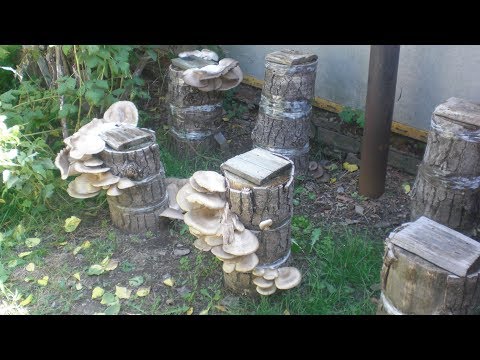

Смотрите это видео на YouTube
Growing morel mushrooms and honey mushrooms at their summer cottage
Speaking about what mushrooms can be grown in the country, one cannot fail to mention morels and honey mushrooms.
In the forests and apple orchards of France and Germany since the middle of the XIX century. in small quantities, morels began to be bred, among which the conical morel is the most common.
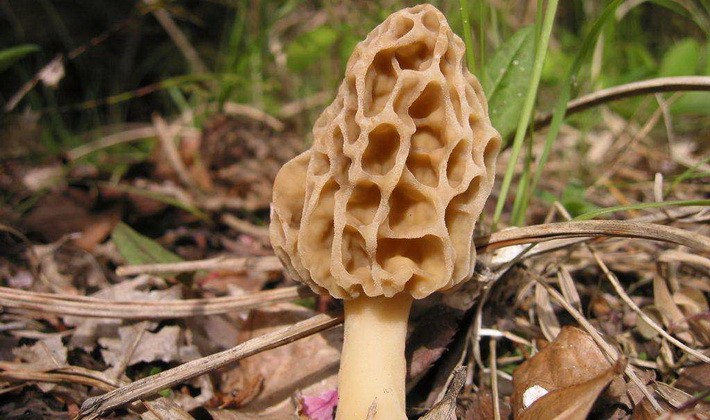

Mushroom pickers are well acquainted with this mushroom. In spring, morel grows in meadows and along forest roads with a pointed, elongated, cone-shaped brown-brown cap. Its closest relative is the common morel (edible) with a round cap. Currently, there are two main ways of cultivating morels – edible and conical.
The first books on how to grow mushrooms on a plot were written in the USSR back in the 30s of the last century. And in the 40s. the cultivation of this fungus on pieces of wood was taken up in Germany. A few decades later, they also developed a method for growing mushrooms using mycelium prepared in the form of a paste.
The study of honey agaric and methods of growing it in summer cottages is also carried out in Our Country.
Cultivation of ring mushrooms in the country
Ringworm can be called the youngest of the cultivated mushrooms, since the technology for its cultivation appeared in Germany in 1969, and it gained the greatest popularity in Poland, Hungary and the UK. However, mushroom growers in other countries are also keenly interested in how to grow these mushrooms in their summer cottage. Cultivating ringworms is quite simple, they need a substrate from straw or other agricultural waste, which is not difficult to prepare.
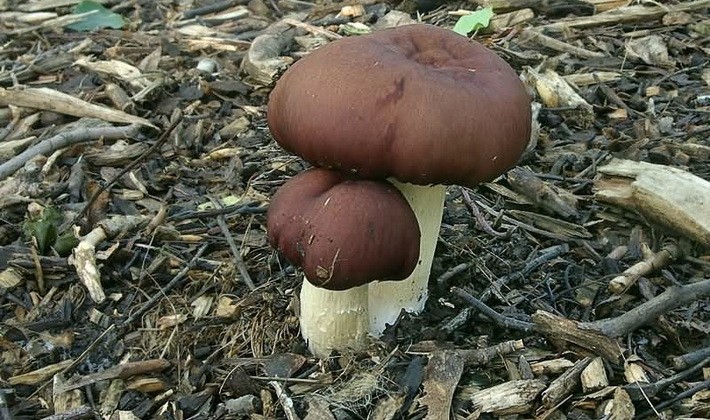

The mushroom has high taste qualities, it can be stored and transported for a long time. Koltsevik is very promising in terms of cultivation and is able to compete with champignon in popularity or even surpass it, however, attempts to cultivate this mushroom in Our Country have begun recently.
Summing up a brief digression into the varieties of cultivated mushrooms, it should be noted that local customs play a significant role in their distribution. However, by the end of the XNUMXth century, a situation began to develop when various mushroom cultures crossed the borders of their homeland and became truly “cosmopolitans”. To a large extent, this is due to globalization and the intensive development of means of communication and the possibility of exchanging information between different countries. For example, oyster mushroom from Europe has spread widely throughout Asia and America. Volvariella, no doubt, will win the hearts of mushroom growers far beyond Asia in the near future.
To grow mushrooms in the country, start with those species that are easy to cultivate: oyster mushrooms and champignons. If your experience is successful, you can try to breed more picky mushrooms.
Tips for growing mushrooms from mycelium in the garden
Below are tips for novice mushroom growers on growing mushrooms from mycelium in a garden plot.
- To prepare raw materials (for steaming, soaking), you will need a container and, possibly, more than one. For this, a traditional urban bath is quite suitable, from which it is very easy to organize the drainage of water, the temperature of which it maintains quite well.
- For growing mushrooms on the site, it is convenient to steam and soak raw materials for the substrate using woven permeable bags (you can use sugar, but first you need to remove the plastic bag that is inside). The bags are filled with dry chopped straw, placed in a bath and filled with hot water.
- Water for steaming is best heated in another container, for example, in a bucket or tank using a boiler, on a stove, in a column, on a stove. Then hot water is poured into a bath with bags laid out there, covered with a thick film and left for 8-12 hours.
- Before sowing the substrate with mycelium (inoculation), it is advisable to grind it well to individual grains. In this case, there will be more foci of overgrowth. Perform this work in disinfected rubber gloves. The mycelium should be removed from the refrigerator 6-10 hours before the action on it.
- It is necessary to fill the bags with the substrate, tamping it very tightly, since excess air and free spaces will interfere with the overgrowth process.
Look at the photo how to fill the bags to grow mushrooms:
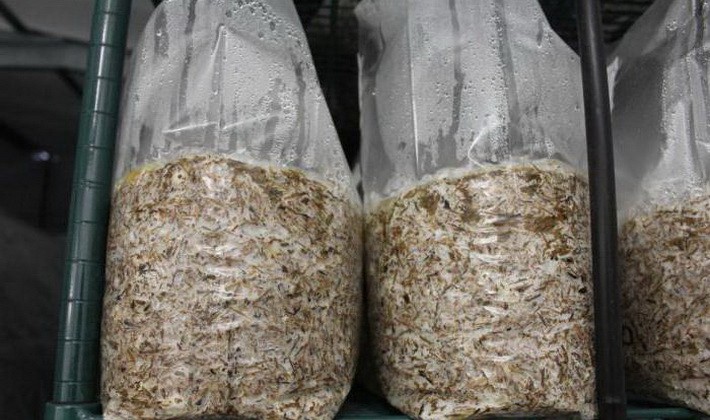

- Bags can be slitted at the end of overgrowing to reduce the chance of drying out of the substrate in their area, as well as infection.
- The bags with the sown substrate should be placed indoors so that it is possible to pass freely between them. At the same time, you need to try to organize uniform lighting and ventilation.
- Humidify the air, bags, etc., but not the mushrooms themselves, as this can cause infection with a variety of bacterial rots.
- When picking mushrooms, their shape must be taken into account. Mushrooms can lean horizontally and should be cut first, as they will no longer develop and may throw out spores.
- If mushrooms are grown for sale, it is important to inquire in advance about the possibility of marketing, cost.
- Although growing mushrooms may sound simple enough, you should not immediately organize a plantation. First you need to try to cultivate at least a couple of mushrooms.
- If the volumes of mushrooms produced are not very large, then certificates and other documents are not needed for their sale, so you can sell the surplus of the plot.
- In order to get the most out of your mushroom cultivation efforts, it is recommended to give priority in each case to your own observations, which are likely to deviate from theory to some extent.
- Those who cultivate mushrooms for sale not directly, but through resellers, as a rule, receive less than those who only sell them. In connection with which we can give this advice: try to combine in your person both the manufacturer and the seller.
- Collaborate with other mushroom growers. This will not only mutually enrich the mushroom growing experience, but will also help, if necessary, to fulfill an order for a large batch of mushrooms. In general, cooperation is very beneficial.
The basics of growing mushrooms in the country are described in this video:
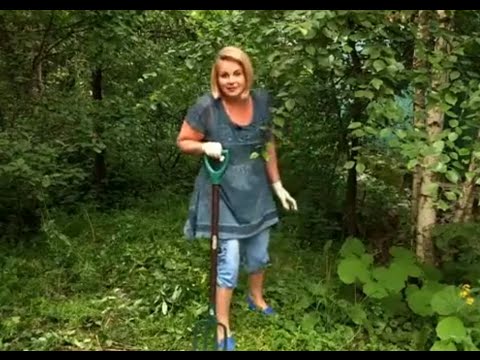

Смотрите это видео на YouTube









